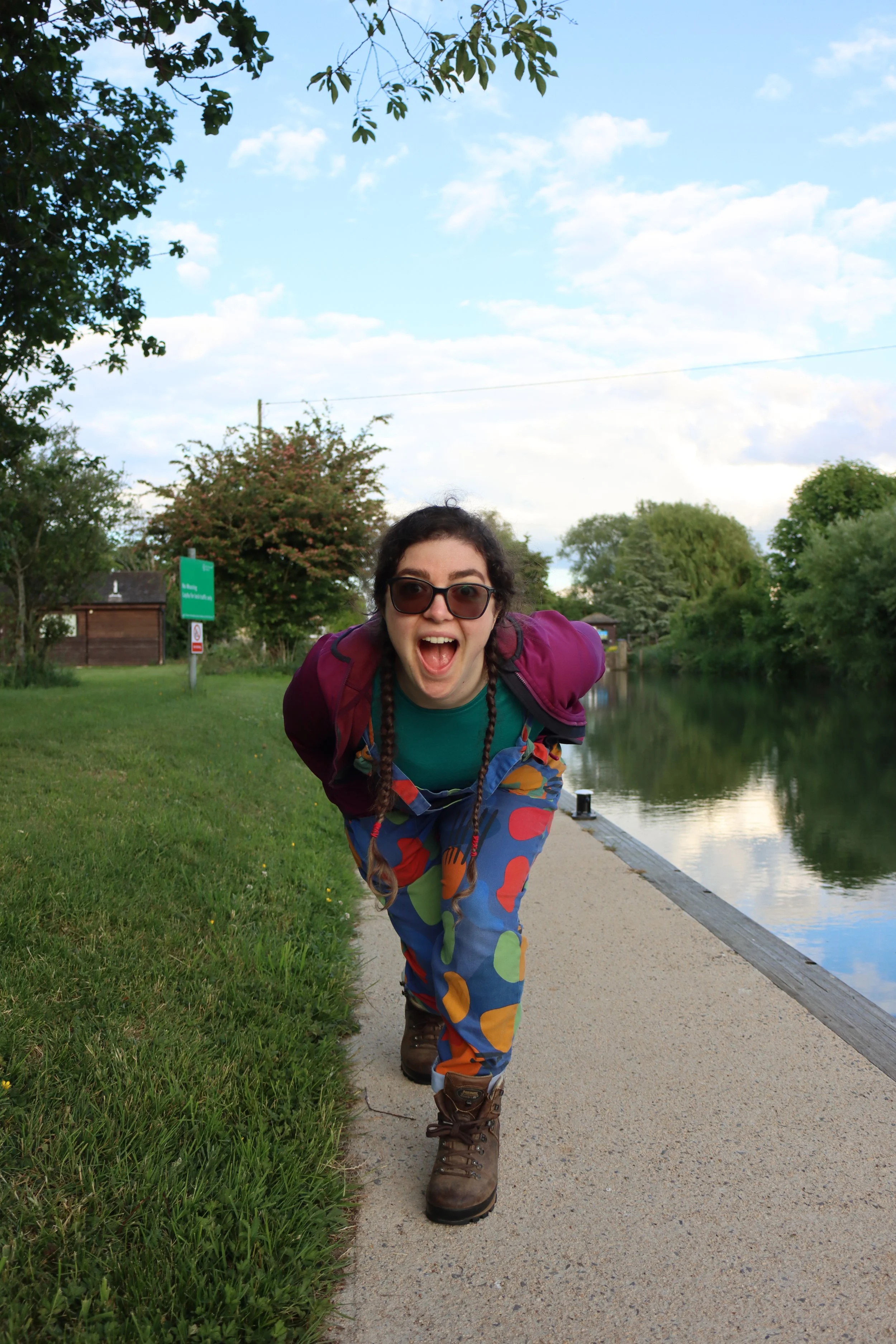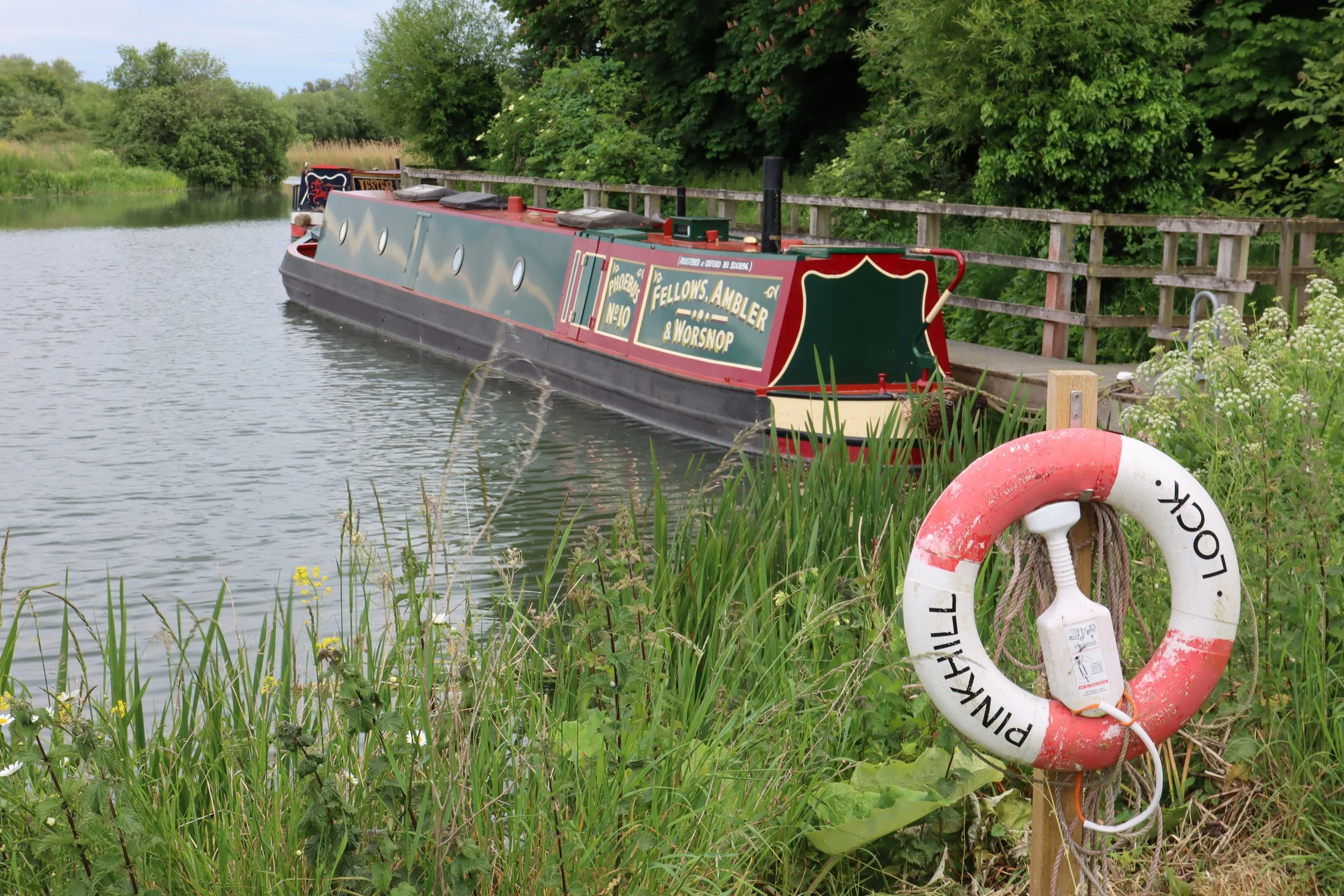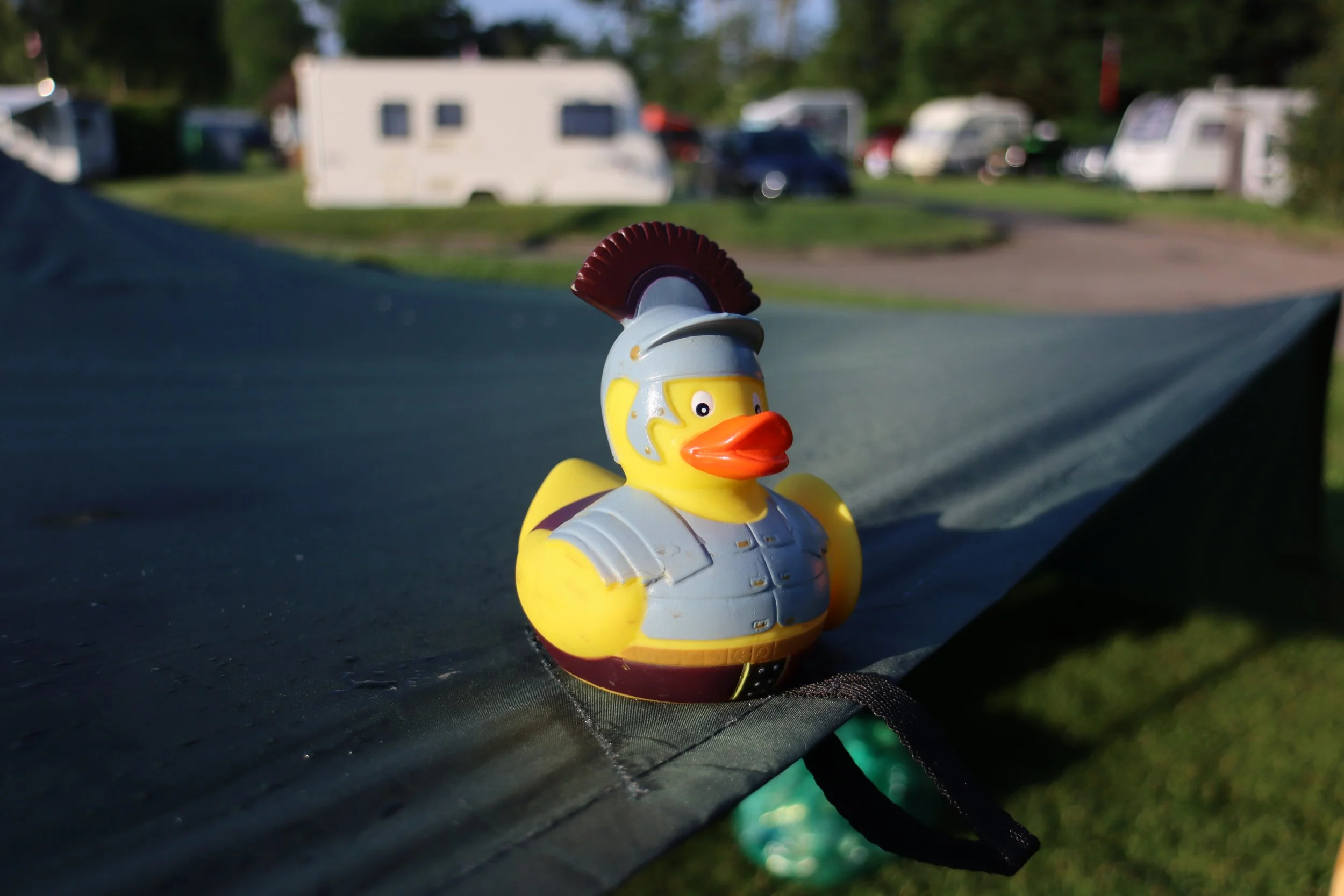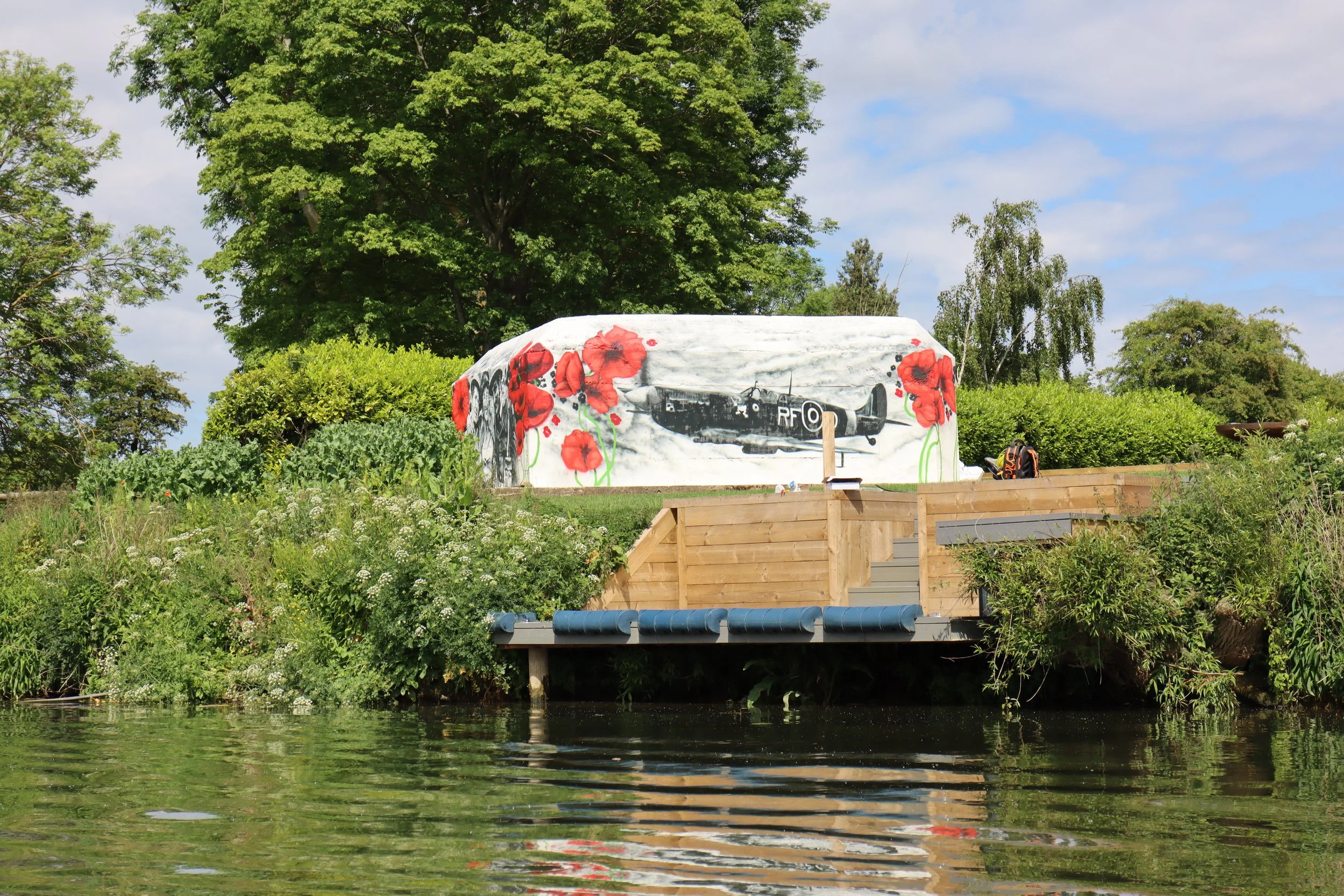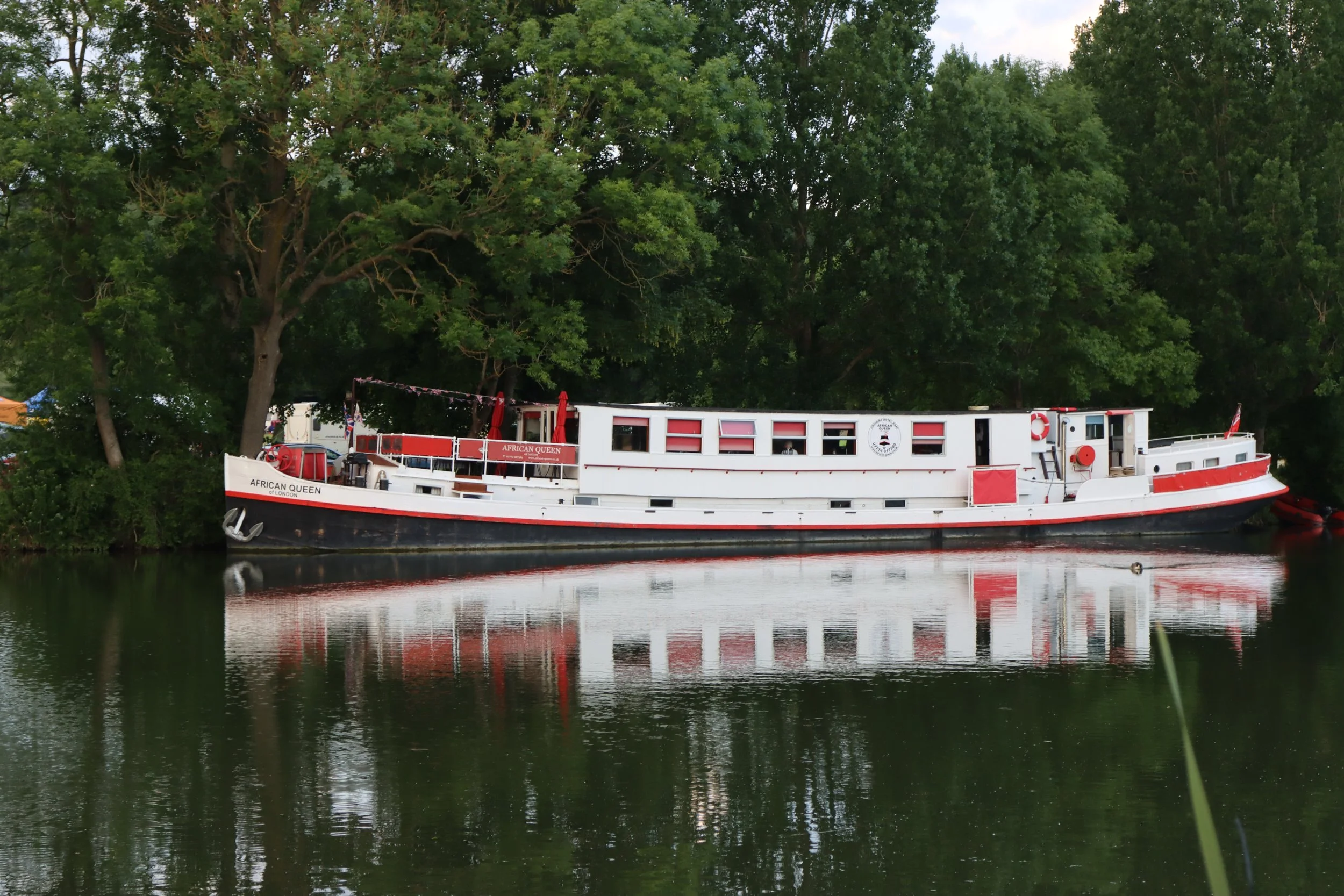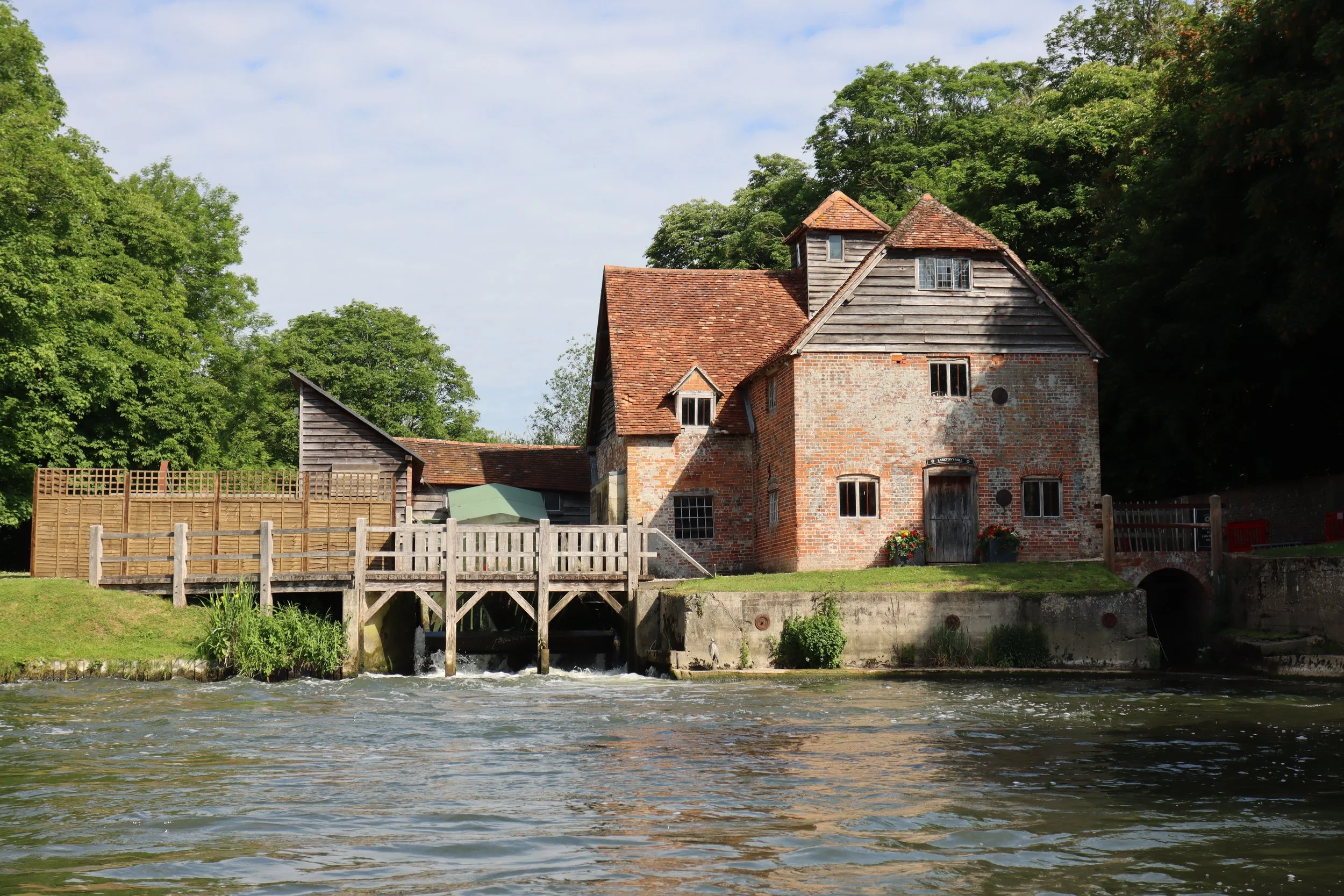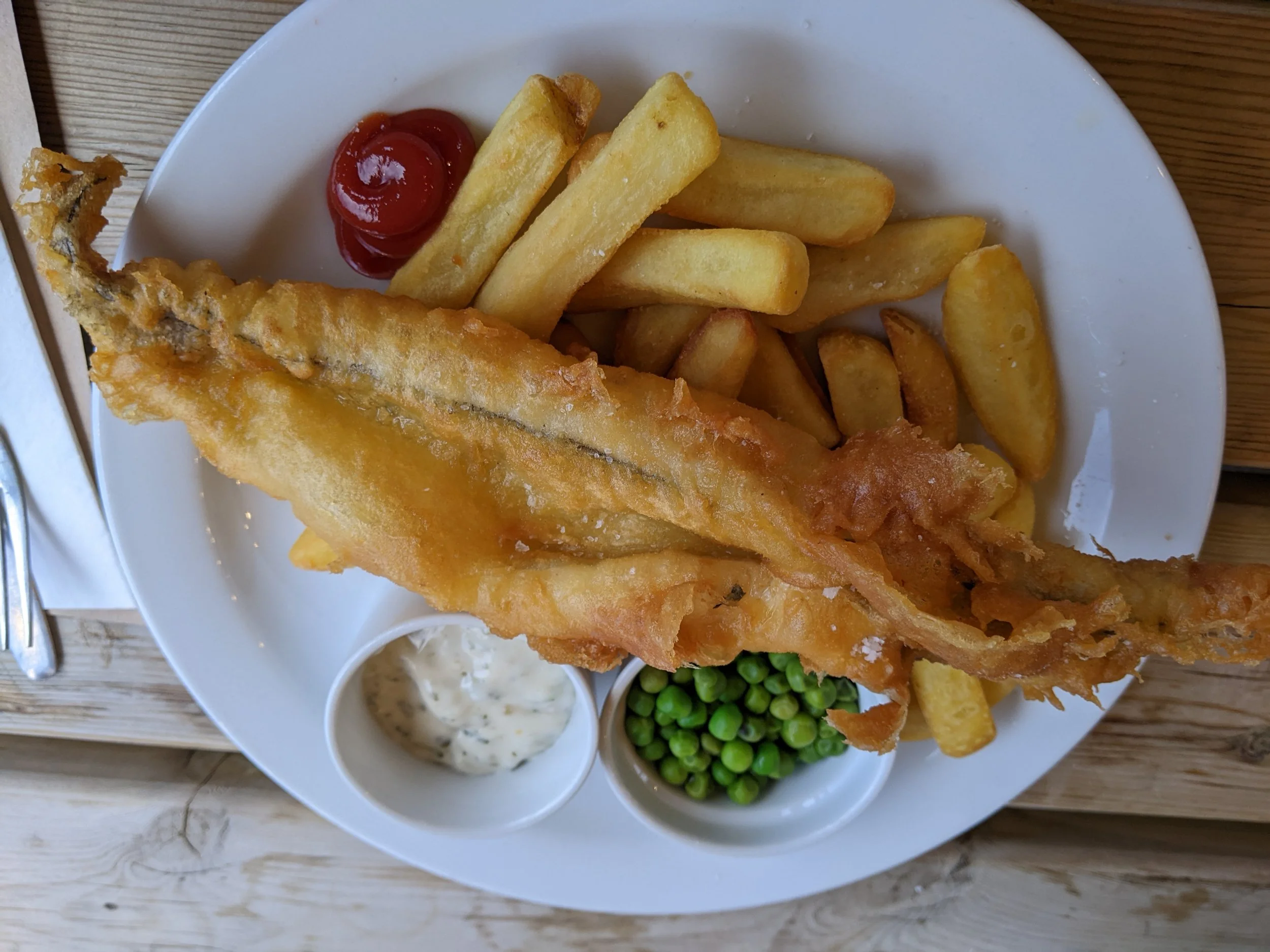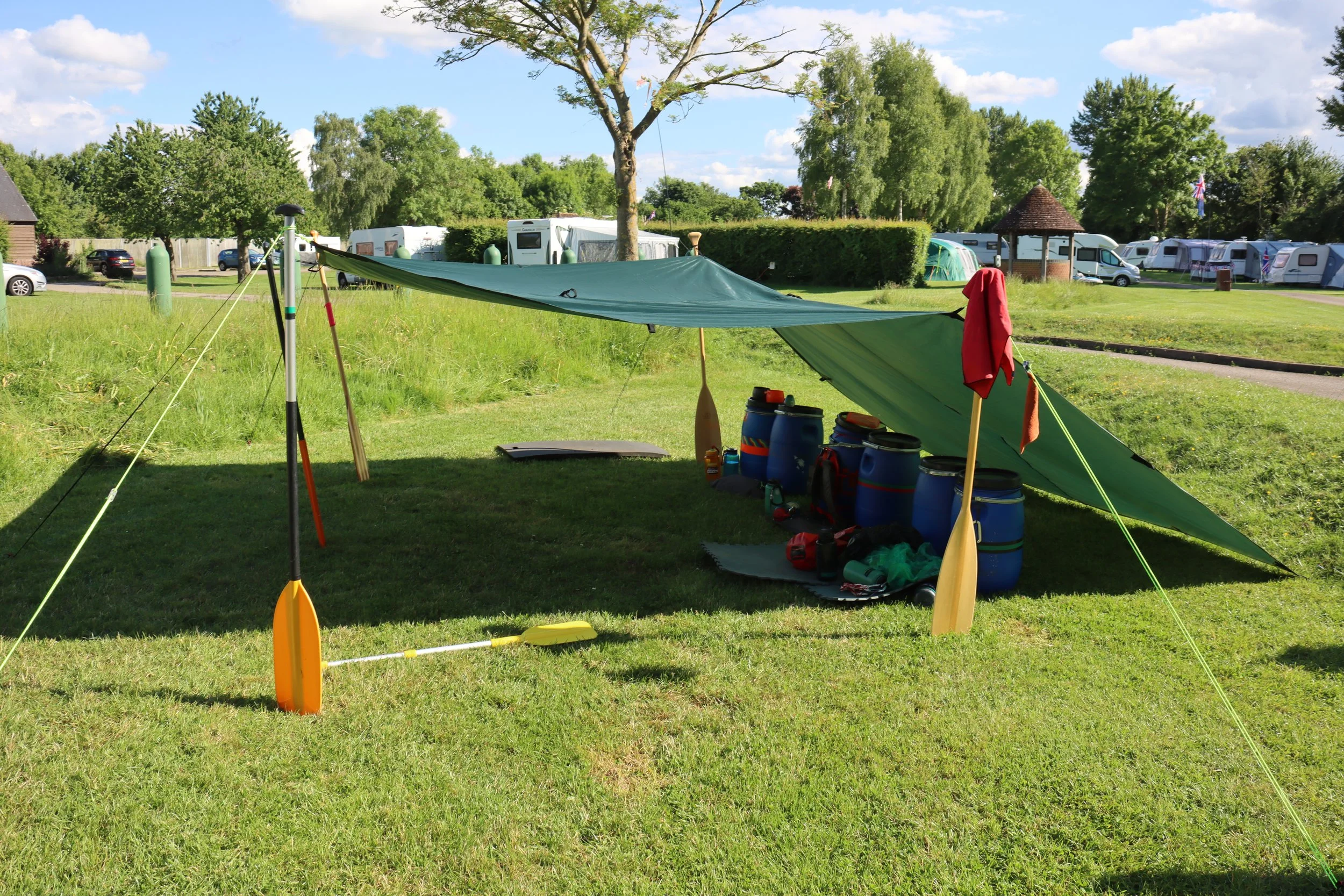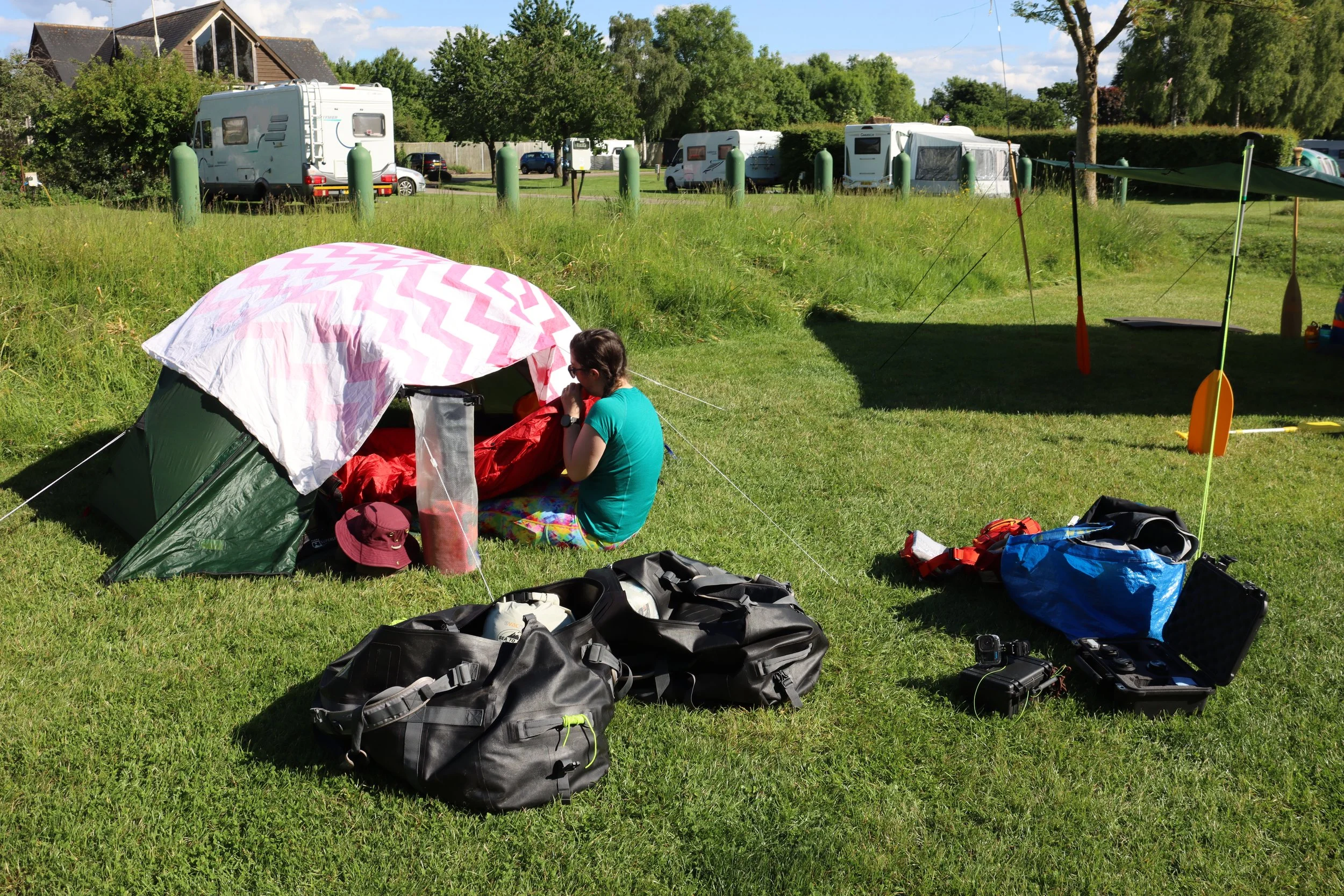Canoeing the Thames: Chewing up the Miles in the Green Canyon
In preparation for our Northern Forest Canoe Trail (NFCT) adventure we wanted to see what paddling longer distances day after day felt like. For this we looked for somewhere in the UK where we could chew up the miles. Now there are not many long distance rivers where you can canoe in the UK. We looked towards the Thames as it is one of the longest rivers in the UK and, helpfully for us, one which you can paddle along.
What we were looking to get out of the trip?
When we had done our trip down the Wye we had found that much of our gear was not optimal for canoe touring. We had made some changes and we were eager to figure out if things worked out as we expected, as well as give ourselves another opportunity to see what else we wanted to improve. As you can probably tell from our website we are rather fond of food, and this trip was no different. We wanted to see if we could get all of our food for a week into a 30l barrel. We knew that we would need to carry two weeks of food for the two of us in a 60l barrel for the last two weeks of the NFCT, so wanted to trial this in particular. It was time to get inventive with the shelf stable ingredients.
When was this adventure?
We did this trip in May 2022, and it’s a previous adventure that really captures our progress in canoe touring (also if you are planning your own trip down the Thames knowing when we did this will give you some idea as to how relevant the information may be. We have been caught out in the past by guidebooks and even maps stating that campsites or other amenities will be present only to find out they have closed years ago).
A little about the Thames
The River Thames winds gracefully through the heart of England, its waters flowing with a history as rich as the landscape it nourishes. Stretching over 215 miles, the Thames is more than just a river; it's the lifeblood for cities, towns, villages, and ecosystems. Once choked by pollution, the river has bounced back remarkably, and transformed into a haven for wildlife. Due to the Thames’ involvement in human history for thousands of years there are many signs of how we have used the river, with historical evidence around every bend. The ever-changing river mirrors both the pulse of human history and nature's resilience.
The section of the river that we paddled has been tamed rather more than most. There are some 29 locks that we would have to pass through on our journey. The locks were put in place to ensure that boats could always use the river, and to this day they still do even if they are now mostly pleasure craft rather than those needed for the logistics of moving goods up and down. Some of the locks have volunteer lock keepers who assist boats through. These people have a wealth of information about the river and the local area, but more on that later. There is some consternation around whether canoes are supposed to use the locks or if they should portage around, but many of the lock keepers would wave us in behind other boats that they were helping through. There was one instance on this trip where we arrived at a lock and there was another canoe in front of us. The lock keeper asked them to get out and portage. We were expecting the same, so pulled up and almost started getting our kit out the boat, when they asked us to wait at the jetty and then they waved us into the lock. It appears that they make a risk based judgement call as to if they think you can control your craft well enough to stay upright and in the correct place in the lock, so that must have meant we looked like we knew what we were doing by this point!. It is worth noting that locks can be dangerous places. You do not want to fall into a lock, especially while it is emptying as the fierce currents can pull you under the surface and through the sluice gates. We ended up going through most locks as the river was so busy with traffic that there was only one occasion where we came across a lock that did not already have one or more boats in it going the same direction as us.
The Thames is such a well used river there is even a government website where you can get information regarding the distance between locks, width of the locks, distance between bridges, and the heights of the bridges. You can find that here.
Overview of our itinerary
When planning a trip for six people it can be tricky to find a time when everyone is free and everyone's work would let them have the time off. We managed to find just about a week where the six of us were available and we tried to get the most out of those days.
Day 1: Getting to the start, Second Chance Campsite
After a week of being at work we all tried to get away as soon as we could. Coming from around the UK we descended on Second Chance Campsite for the night before our journey started. Before the trip we had arranged with the campsite to leave our cars parked there for a week for a small fee. We had a wonderful meal made from fresh ingredients (the last one before we got to the other end, given our shelf stable food trialling).
A tasty tasty steakwich, with fresh lettuce, a sharp cheese, in a doorstop sourdough bread. Note the 30L barrels that we were using to carry all our food, cooking equipment, and wash kits.
Day 2: Rushey Lock
Distance Paddled = 27 km
Waking up to the sound of rain could not dampen our spirits, as this was to be the farthest that any of us had paddled in a canoe in a single day. We were buzzing with excitement to get on the water and start clocking up the miles. It took us as a group an embarrassingly long time to get on the water, so it was a good thing that we were doing this at the height of summer and had plenty of daylight.
We found the river at this point to be not much more than a stream. Picking our way through reeds and dodging a few low hanging branches we made steady progress. On reflection this was probably the most technical paddling of the whole trip, bar one canoe shoot. There were only a couple of bumps and scrapes, which resulted in one or two choice words directed at tree branches along the way. However, it was not long before the river opened out and we could easily dip our paddles in the water without concern of scraping the bottom or getting stuck in weeds.
The first lock we came across there was no one around and we decided to portage around it. Now this was something we needed to get better at! There was so much faff and our kit did not help. This was something we knew we could improve on from both an equipment, and a process point of view. We spent almost as much time discussing the portage as we did doing it in the end, and this has now meant we have a few things put in place to help us improve our portaging (mostly more portage friendly packing, but also some better communication).
We were conscious that we had many miles to go that day and so we did not hang around. Lunch and breaks were short, and we just kept putting in the miles. The water was relatively slow moving and so we found we fell into a rhythm. Before we knew it we were at Rushey Lock.
Despite our furthest canoe paddling in a day Katrina was still full of beans. Spirits were high and our confidence was boosted that we could do longer journeys, and many miles are in fact easy to do.
This lock was incredibly peaceful; we did not see anyone else that evening. There was a small patch of flat grass to pitch our tents on, a toilet and even a shower! The sun came out and we were treated to a beautiful sunset.
Day 3: Pinkhill Lock
Distance Paddled = 22 km
The question we were all wondering was how would the second big day go? Turns out we could feel it in the muscles a bit, but nowhere as much as we were expecting. The training was paying off. The river traffic was much heavier in this section and we started to come across rental boats.There are a few places that you can hire river cruisers on this section of the Thames. Many of these boats are (understandably) not necessarily piloted well. We had to keep a keen eye on these boats as there were a few times where they did stuff that we were not expecting.
This is a picture of us waiting at a lock due to a number of rental river cruisers attempting to navigate the other side of the lock. Instead of trying to portage around them we took the opportunity to moor up, have a snack and wait for the chaos of the other side to sort itself out.
We made it to Pinkhill lock in good time and it was one of the few places that we camped along the route where we pitched our tents in trees! This gave us the opportunity to throw up the group tarp and make a rather pleasant shelter. This was fortunate as we experienced a series of short, sharp showers as the evening went on. Speaking of showers, there was an electric shower at the lock where, if you were staying overnight, the lock keeper would be able to give you access. This was a welcome amenity as we had all worked up quite a sweat over the previous couple days. Later in the evening a couple of American tourists walked onto the lock campsite, as they were walking the length of the Thames way which is a footpath that runs close to the river. They were not best prepared for the route, however, and assumed there would be somewhere to get food each night. This is not the case around Pinkhill Lock. This lock is miles away from the nearest pub, let alone a restaurant. They had enough calories for evening, but in the morning we did provide them with some porridge to set them up for the walk ahead.
The picturesque Pinkhill Lock. At this point in the river there are also many canal barges as well as river cruisers. These boats are slow and we passed many of them during this trip, some even have amusing names.
Day 4: Abingdon Lock
Distance Paddled = 26 km
This day was where the river changed from winding through farmland to winding through the first of the major built-up sections. It was not only the surroundings that were variable on this day, but also the weather. As we wound our way towards Oxford the heavens opened, filling our boats with a couple of inches of water in a matter of minutes. We don't often get rain like that in the UK, however it is getting disturbingly more common. This highlighted that we needed to sort out wet weather gear that we could get on much quicker. We all got a little damp during that first downpour. Fortunately the weather picked up in the afternoon, and we were able to dry out. While paddling through Oxford we came across a Roman themed rubber duck floating in the middle of the river. After some discussion and various names suggested we would like to introduce you to Dionysus the Duck, our mascot for the rest of the trip.
Dionysus the Duck proudly standing sentry over our campsite later on in the week.
Day 5: Bridge Villa Campsite
Distance Paddled = 22.9 km
Something happened this morning that in all my years of camping I have never previously experienced. While we were having breakfast one of the tents was left with the outer door open to assist with drying out the condensation. A robin (small bird) flew into the tents and got between the inner and the outer layers and could not work out how to get out. We attempted to coax the bird out, but to no avail. The way we resolved the situation was to take off the outer of the tent and allow the bird to escape. Unfortunately this was not before it managed to make quite a mess on the inner mesh. Quite a bit of cleaning was required before the tent could be put away that morning.
The little robin trapped between the inner and outer of one of the tents. Note the mess on the inner mesh it made in its panic.
With the river now not only being near a large city, but also being wide and deep, the amount of river traffic had really picked up. This made for some interesting times navigating around novice boat users, and making sure our boats were not swamped by speeding boats bow waves.
Now that we were in a well populated area we started to see some WW2 Pillboxes in pretty good condition. What is a Pillbox you say? A Pillbox is a type of fortification that the UK placed in strategic locations all across the country during the second world war to assist in the event of a land invasion. They are often, but not always, made out of concrete and normally have holes in them(usually called loopholes or embrasures), through which defenders can deploy weapons. If you are interested in these forts then Robert would recommend the book “Pillboxes and Tank Traps” by Bernard Lowry, which details the history, construction, and preservation of these quirky lumps of history.
A rather memorable Pillbox which had been decorated with a spitfire, soldiers, and poppies. This is a good example of how close to the river bank some of these fortifications were placed.
The campsite was a small portage from the river. Again this proved to us that we needed to make significant changes to our load carrying equipment. We came to the conclusion that we needed to devise a waterproof rucksack type arrangement. There is a good reason that portage bags are a thing. They’re not so big in the UK, but we were sure we could track some down; the internet is a big place afterall.
We arrived in good time with some blazing hot sun. We took the opportunity to dry a load of damp kit and walk across the bridge into the town for a well earned ice-cream (the only additional food to that from our barrel since we began).
Day 6: Mapledurham Lock
Distance Paddle = 20 km
By this point we were all surprised that we could get up in the morning and feel OK after the many kilometres we were chewing up, but by this point we also knew there wasn’t too much further to go, so maybe that helped a little. Much of the water on day six was relatively flat, out of the wind and easy going. The boats we were negotiating around were getting bigger and more frequent though.
This is the size of boat that we were navigating around frequently. Believe it or not this is a floating hotel.
The Mill at Mapledurham Lock may look familiar to some as it has popped up in the media in a variety of locations over the years. This includes, but not limited to; the cover of Black Sabbath's 1970s Album “Black Sabbath”; the film “The Eagle has landed”; episodes of Midsomer Murders, as well as Inspector Morse; Richard Hammond's Blast Lab; Taboo; and Mortimer & Whitehouse Gone Fishing. While floating past it we can see why, it has another timey appearance to it.
The somewhat famous and oddly recognisable Mill at Mapledurham.
We were treated to a mild evening and fantastic sunset (unfortunately we did not manage to get any pictures), and the prospect of another 22km tomorrow did not faze any of us, surprisingly.
Day 7: Swiss Farm Touring and camping
Distance Paddled = 22 km
With the speed we were travelling at this point there was the real potential that we would reach Henley far sooner than we had intended. We packed up with an almost carefree attitude, having now all found our rhythm and order of doing stuff. People were up, breakfast was made, tents were down, and we were back on the water with relatively little fuss.
The number of smaller day boats out enjoying the river increased even more the closer we got to Henley, and so did the number of paddle boards. We also came across this amusing post box that was situated on a bridge.
One of the most amusing locations we have seen for a post box.
One thing to watch out for if you want to paddle the Thames is the Henley regatta. If the regatta was underway it would have been a much more difficult section to pass though, but fortunately we were ahead of it by a matter of days. As we passed through the town we could see people setting up marquees and a variety of temporary buildings. We arrived to our get out point around 15:00, much sooner than we had planned when sorting out the trip. We pulled out the boats and portaged to the campsite. Once we had settled, had a drink and a bite to eat, the car shuffle commenced. We picked up one of the cars from the Rugby club long stay car park, and drove it back to the start of our journey at Second Chance campsite, then drove back all three cars back to Swiss Farm, our campsite for the final night. This took a bit longer than expected due to traffic, with us not getting back until around 19:00. Once back at Swiss Farm we had a decision to make. Either stay the night we had booked there or go home. Some of the group decided to go home (which turned out to take much longer than expected), whereas we decided to take it easy and stay at the campsite for the night.
The campsite had hot clean showers, which were much enjoyed after the last couple of hot, sweaty days. Also they had a restaurant on site which, for ease, we decided to get food from. There was nothing fancy on the menu, but the fish and chips we ordered were well received.
The fish and chips from the restaurant at Swiss Farm campsite.
The campsite was not very busy at all, and considering the number of people, very quiet. We had plenty of space to pitch our tent well away from anyone else.
Day 8: Home
After a refreshing night's sleep it was time to pack up and head home. The drive back gave us time to reflect on the adventure we had just completed. There may have also been a cheeky stop to pick up breakfast from a bakery on the way. Then the post-trip laundry and kit sorting commenced.
Navigation
This adventure has to be one of the easiest bits of navigation that we had ever done. The route cards we wrote worked well in combination with the maps. The frequency of the locks gave us great checkpoints as to how far we had gone, as well as making our speed calculations relatively easy. Due to the way in which the water flow is regulated the winding of the river itself does not change much and so the bends on the maps are surprisingly accurate for a river.
Accommodation
We wanted to carry all our camping kit and use it day after day unsupported. Now with this in mind you would think that we would have wild camped. However, the Thames is populated almost all the way along to an extent that wild camping as a group of six would have been quite the challenge. We are not saying that it is impossible, but it would likely take more local knowledge than we had. So during this trip we used a mixture of commercial campsites and camping at the locks. To camp at the locks we had to make contact with the lock keepers and book. This is easier said than done. Most of the lock keepers are volunteers and spend most of their time outside helping people through the locks. The only way we found to get in contact with them was by calling. It is understandable then that when you call the lock you may not get an answer. For some of the locks we had to call multiple times before anyone picked up. Unfortunately in 2024 the canal and river trust have made the decision due to budget cuts to prohibit camping at the locks. This would make doing this trip unsupported much more difficult now.
Which means that for those of you looking to have your own Thames canoeing adventure if you want to do it unsupported it is going to be quite the challenge if the camping at the locks remain closed.
Water
Water, water everywhere - but not that you would want to drink
The section of the river that we paddled in the conditions we paddled it in was relatively flat. There was only a little current so if we stopped paddling we would gently drift downstream. The quality of the water was low and even with water filters we would not have felt comfortable drinking it. Fortunately most of the locks have water points that you can use to top up. We did learn, however, that we need to find an easy, portage friendly way of carrying more water where there is not the opportunity to filter.
Lessons learned from this trip
We have been trialling these simple questions to help us get the most learning we can out of an adventure.
“What replicable new learning did we gain from what went well?”
So much went well for us on this trip, it really felt like as a group we were figuring out how this could work for a much longer trip.
Food
It turns out we can comfortably pack a week's worth of food and toiletries for one person in 15L. Meaning that the two of us can use a 30L barrel for a whole week’s worth of food. There were sufficient calories and volume that no one felt hungry throughout the week. The only additional food that we purchased was an ice cream, which was more for the fun of it than actual hunger. This gives us confidence that the two of us could fit two weeks worth of food in a 60L barrel. This will make travelling in bear country in later expeditions much easier.
Pelican Cases for Electronics
We know that Pelican Cases are not light (or cheap), but they do give us the piece of mind that the contents will stay dry and be protected from any knocks and bumps that come with adventuring. Despite heavy rain and a couple of bumpy portages the assurance that the electronics would be safe took a level of concern out of the week. As soon as that lid is snapped shut everything inside will be all good. Also they make a nice little table for personal admin in the tent.
Group tarp
Having a group tarp that we can use as shelter for cooking and eating is well worth carrying. This will definitely be something we will look to take with us on future trips. You may even be able to see that we have used throw lines to hoist this tarp up into the canopy.
Our group tarp set up at Pinkhill Lock. We managed to take advantage of the trees at the camp site for this one night.
Due to the lack of trees in many of the locations we camped on this trip we often made use of the paddles and poles to hold up the tarp. Despite being a little low, it gave us somewhere to get out of the sun, and rain, and sometimes both at the same time!
Just having somewhere not in the tents to cook and eat under when it is raining is just so helpful. They are not a common site in the UK, probably due to the lack of usable trees. However we are carrying paddles which can easily act as poles and it is a doddle to chuck up.
Bedding
Our new Sierra Designs Backcountry Bed duo was incredible! We can not recommend it enough for couples that like to cuddle, or generally be touching each other while sleeping. However we are going to need to sort out our mats and a liner. We took a cotton duvet cover as a sleeping bag liner this time. It looks like it will be something we will have to make as there are not many (or really any) double sleeping bag liners on the market. With respect to the mats that fit in the back we need to find two that are the same and fit together nicely. Our two current Therm-a-Rests are different thicknesses, lengths, and widths. This means that they do not sit together very well in the sleeping bag.
This is us airing out the cotton duvet cover as it got damp. Cramming it back into a waterproof bag when not in use probably does not help. We have now taken to getting our sleeping system out as soon as we can when we get to camp to give it a chance to air out before we go to bed.
“What replicable new learning did we gain from what did NOT go well?”
Firstly nothing major went wrong on this trip so the things we have identified are more things that will make future adventures more fun or pleasant, rather than immediately necessary.
Portaging
This has to be the single most important lesson identified and we need to do something about it. We are a mess at the moment when it comes to portaging. From both an equipment and action perspective.
None of our bags seem to be the right type. We have too many bags that require too many trips back and forth. Also there somehow seems to be a lot of stuff floating around in the boat. During the trip we identified that we think that we could probably make do with 1 x 120L bag, 2 x 40L bag, 1 x 60L barrel, and a pelican case big enough for all the electronics. Then the only things we would have floating (still attached but not in a bag), 2 x Nalgene, 1 x map, and 1 x spare paddle. This would mean that we could portage long distances with some in the boat and some carried. Then for when we would need to carry the boat it would be 2 trips.
After some group discussion we all found it is less helpful to “help” move someone else's kit, rather than just letting each boat deal with their stuff. We have now implemented the rule that “you are the only one to touch your kit unless you are directed by the owner” this sounds harsh, but it seems to make us all more aware of where kit is, hopefully reducing the chances of losing anything on a portage. We will ensure this gets used in future canoe adventures.
Waterproof Jackets and Trousers
Firstly we need to find a way of storing them which is easy for us to gain access to. We were caught out by a heavy shower and both got soaked. We need to find some sort of packing system where we can still access them quickly, but they are safely stowed so we do not lose them in the event of a capsize. We are thinking about making a 40L bag a “day bag” with all the things you may need access to throughout the day. Then place it in a location where Katrina can access it and fetch out the waterproofs, if and when we need them.
Robert’s waterproof trousers need to change. For years of walking he has been a fan of the waterproof trousers with inbuilt braces. However these are just not easy to get on and off while in a boat, as they require the taking off a buoyancy aid (BA) and putting it back on afterwards. A pair of simple pull-on waterproof trousers would likely be easier. We just need to make sure that they can be pulled on while wearing boots.
Footwear
Day after day in neoprene water shoes is not nice. Our feet did not enjoy it and we are not too proud to say that the stink was … impressive.
Katrina taking advantage of being able to change out of neoprene shoes and into walking boots.
We need to find some shoes that can go from dry to wet to dry multiple times, not stink, and not destroy our feet. This is going to take some looking into.
Volume of a Petrol Stove
We both love our MSR Dragonfly stove, it is reliable and controllable, however it is a tad loud. This means that while it is on, conversation around it is limited. If the evenings are going to be in close proximity to the rest of the group, and where the majority of the conversations happen, then we need to make sure that our stove does not end up being something that inhibits conversation. We are reluctant to get rid of it but, there may be some way we can modify the burner so it is not of the roarer type, so we shall investigate further.
Carrying Emergency Equipment
We have decided that we want to carry some personal emergency equipment on our persons. There is a fantastic article by Paul Kirtley titled “Wilderness Canoeing: Personal Bushcraft & Survival Kit”. That has what we consider a well thought out loadout, however, our buoyancy aids just don't have that much room in. So we have placed most of it in the bladder pockets of our BA’s. Rob's BA is just not meant to carry this much stuff and so another solution needs to be found.
Time to get on the Water in the Mornings
For some reason it was taking us what seemed like an age to go from waking up to being on the water. If you are not starting paddling until 09:30 to 10:00 in the morning then you have already eaten a big chunk of your possible daylight hours. If something goes wrong in your day then you just don’t have as much daylight to sort it out. Everything is harder when expeditioning in the dark. When walking we can go from waking up to being under way in less than an hour, and that includes a cooked breakfast, without any of it feeling rushed! We need to find ways of streamlining the mornings to ensure we have more time to do the activities. We started trying to find the marginal gains for getting quicker in the morning, and we will continue to do so.
Loading and Unloading the Boats
With three boats entering and exiting the water at every portage we have found that it can be quite the bottleneck waiting for each boat to individually load up. Now this may not always be the case, and indeed there were a few situations where all of the boats could ingress or egress independently. However it still somehow felt like it took a long time to get all the kit in and tied down. There is definitely room for improvement. This problem is likely going to get easier when we condense and change the equipment we carry.
Capturing Footage and Pictures
Quite simply we did not take enough, and what we did very rarely had Rob in it (as he was behind the camera). It is going to make documenting adventures difficult if we don’t capture the content. There was also the concern of using the power from the batteries and being left without the possibility of capturing something “cool”. We need to find a way of reducing that concern.
“What changes can we make to the way we go about doing things to improve our future adventures?”
Continue investigating dehydrated shelf stable foods that are suitable for storage in a barrel for a week (though lucky for you, dear reader, you might not have to investigate as much, as you can just head over to our Outdoor Pantry).
Sort out a single Pelicase for all our electronics.
Carrying a group tarp really is worth it.
Take the Sierra Designs Backcountry Bed Duo on every trip.
Find and take a sleeping bag liner made of something breathable.
Source two sleeping pads that fit the Sierra Designs backcountry bed.
Follow the rule that during portage “you are the only one to touch your kit unless you are directed by the owner”.
Reduce the number of individual items that need to be transported during a portage.
Set up and use a “day bag” with all our lunch and waterproofs in.
Rob needs to find some more suitable pull on waterproof trousers.
Find some footwear that will not destroy our feet if they are wet for weeks at a time.
Reduce the sound level of stoves at evening times. Turning petrol into noise is just not appreciated by anyone.
Find a new solution to carrying personal emergency equipment.
Continue looking for marginal gains for getting sorted in the morning.
Take more images and video. Don't be afraid of using batteries and memory space.
The very act of writing these down brings into perspective that none of these are massive changes but rather incremental improvements.
Would we recommend this trip?
As with every adventure we go on, people ask us “would you recommend it?” and that is a difficult question to answer. It was a pleasant week floating down a river. If you want white water and to get away from civilization, then this is probably not the one for you. However, if you want to do some canoe touring where you can crank through the miles and see some historic sites with relatively easy resupply then go ahead.
Well, they’re not wrong


